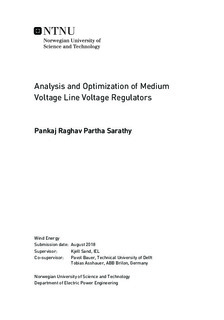| dc.description.abstract | In recent years, distribution networks have been facing voltage quality issues due to the influx of renewable energy. Rural areas which are ideal for renewable energy development due to large vacant areas are faced with grid voltage variations due to long distribution lines. Because of the stringent conditions laid by the Distribution System Operators (DSOs) on voltage variations, voltage regulation is becoming increasingly important in the distribution grid. A complete grid reinforcement by replacing the conductors can be very expensive for the DSOs. Active solutions such as shunt and series compensation provides an economical solution to address the voltage regulation issues in the distribution grids.
The initial part of this work focuses on quantitatively studying the impact of series and shunt compensation on increasing the grid capacity of a Medium Voltage(MV) line compared to a grid reinforcement with conductor upgradation. The analysis was done on a 20 kV, 10 MVA radial line with 5 loads distributed equally along the line, and a generator at the end of the line. An algorithm was developed in MATLAB/ Simulink to determine the allowable grid capacity to stay within the thermal and voltage limits for different voltage regulation strategies. The study indicates that the series voltage regulation with Line Voltage Regulators(LVR) is an effective solution in increasing the grid capacity by actively regulating the voltage in the grid. The MV-LVR product offered by ABB consists of dry-type transformers and mechanical contactors for changing the tap position. However, dry-type transformers are bigger in size and more expensive than oil-type transformers. To reduce the cost and the size of the MV-LVR, the study is focused on the feasibility of a MV-LVR with oil-type transformers and On-Load Tap-Changers (OLTCs). The second part of the project work focuses on developing an economical LVR configuration with an oil-type transformer and a mechanical OLTC. ECOTAP VPD III 100 from Maschinenfabrik Reinhausen (MR) was selected as the mechanical OLTC to perform the tap changing operation in the LVR. ECOTAP OLTC enables low maintenance of transformers due to the use of vacuum switches for quenching the arc during tap-changes. 7 LVR configurations with single and two active parts are investigated. All the configurations are finally compared for their cost and range of operation. The final part of the work focuses on a feasibility study of a power electronics based OLTC for LVR applications as mechanical OLTCs require regular maintenance. Anti-parallel thyristors are used as the solid-state switches for the LVR application due to its low cost and losses. Commutation instants are defined for the complete power factor range for the thyristor based OLTC to have no/controlled short circuit during tap-changes.
The two active parts LVR configuration constructed with a center tapped feeder transformer and a booster transformer with the ECOTAP VPD III 100 OLTC is economical for a 20 kV, 10 MVA feeder line. A LVR rated at 20 kV, 10 MVA with 6 % voltage regulation using the selected configuration was simulated in MATLAB/ Simulink. A 400 V, 5 kVA low voltage setup was built with the ECOTAP VPD III 100 OLTC, and the LVR configuration was verified with experimental results. The feeder transformer model with two taps was simulated in MATLAB/Simulink for switching up and switching down operation with a thyristor based OLTC for capacitive, inductive and resistive power factors. The complete LVR system with thyristor based OLTC placed in a MV distribution line was simulated to verify the control algorithm used for the commutation. The thyristor based OLTC successfully performs tap-changes for a LVR system with a low voltage stress on the thyristor, and low short circuit currents between the taps for certain power factor angles during the commutation process. | |

